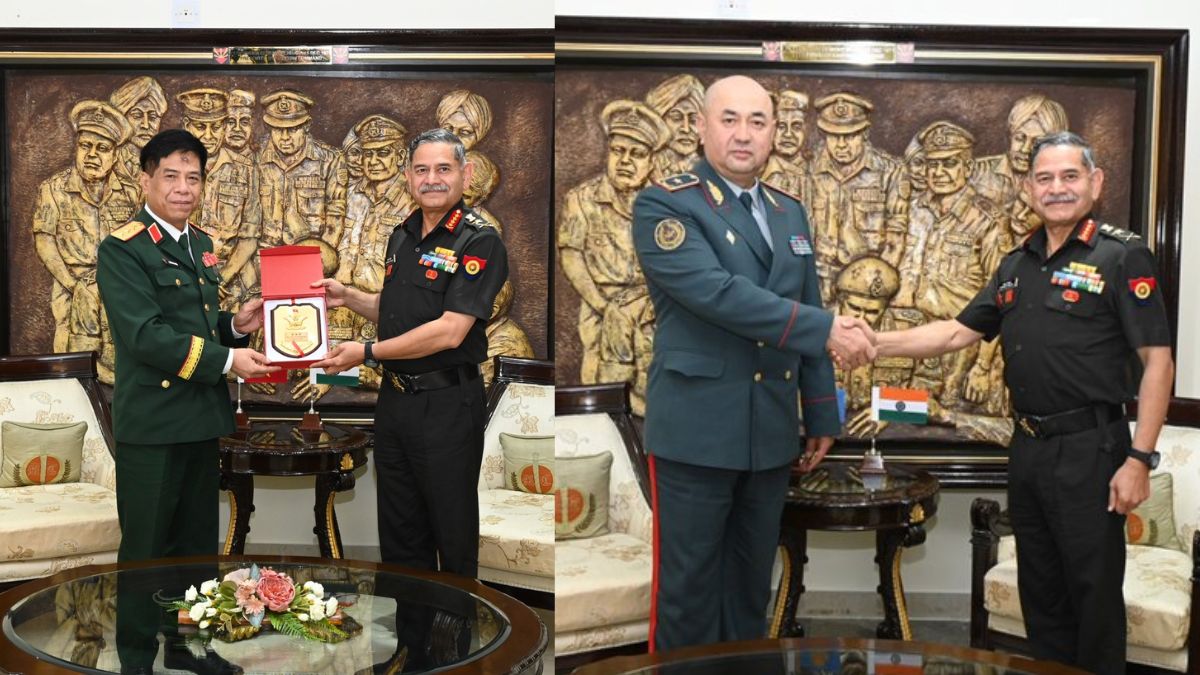As India hosted the United Nations Troop Contributing Countries’ (UNTCC) Chiefs Conclave, Chief of Army Staff (COAS) General Upendra Dwivedi engaged in high-level talks with several military leaders from several countries including France, Kazakhstan, Vietnam, among others.
In a calibrated push to strengthen India’s military diplomacy in Eurasia and Southeast Asia, COAS General Dwivedi held separate high-level meetings this week with senior military leaders from Kazakhstan and Vietnam. The discussions focused on capability enhancement, defence cooperation, joint training and emerging security partnerships.
However, an unexpected social media moment involving a painting in one of the meeting rooms also drew public curiosity online. Pictures from Gen Dwivedi’s meetings with Kazakhstan and Vietnamese military leaders feature the iconic mural of the 1971 India-Pakistan war surrender in the background.
The picture that spoke a thousand words
In a background of the COAS’ high-level meeting was the famous photograph showing Pakistan’s Lt-General AAK Niazi signing the Instrument of Surrender in December 1971, sitting alongside Lt General Jagjit Singh Aurora and others. Worth noting here is that the picture piques an even greater interest in view of India’s recent conflict with Pakistan.
The photograph was shifted in last year in December to the Manekshaw Convention Centre in Delhi from the Army Chief’s office in Raisina Hills.
What was discussed during India–Kazakhstan defence dialogue?
General Dwivedi met his Kazakh counterpart, Lieutenant General Mustafaev Marat Rakhimovich, during his official visit to Kazakhstan. The two sides reaffirmed long-standing military cooperation, joint training engagements, counterterrorism collaboration, defence technology partnerships.
India and Kazakhstan already conduct joint exercises like Exercise KAZIND, and the latest talks aimed to expand their scope.
Why does Kazakhstan matter strategically to India?
Kazakhstan is a key Central Asian republic with proximity to Afghanistan and China, membership in the SCO and CSTO, shared concerns over terrorism and regional security, growing interest in Indian defence platforms and training. Both militaries emphasised strengthening interoperability and broadening engagement across forces.
What were the key outcomes from COAS’ meeting with Vietnamese army dy chief?
In a separate engagement, General Dwivedi met Vietnamese Deputy Chief of General Staff Senior Lieutenant General Nguyen Hong Son. Key talking points included defence exports from India, joint military training and high-altitude warfare expertise, maritime security and Indo-Pacific cooperation, technology sharing under the “Act East” policy.
With China’s assertiveness in the South China Sea and Line of Actual Control (LAC), India-Vietnam defence ties are becoming increasingly strategic.
How do these engagements fit into India’s broader defence diplomacy?
General Dwivedi’s back-to-back meetings underline India’s effort to strengthen military partnerships in Central and Southeast Asia, expand influence beyond its borders amid shifting geopolitics, counterbalance regional threats through collaboration, boost defence exports and joint production, enhance interoperability with key partner nations.
These interactions also fall in line with the government’s emphasis on “Neighbourhood First”, “Act East Policy” and Central Asian outreach.
By engaging both Kazakhstan and Vietnam, nations situated in two different but strategically sensitive regions, India signals its intent to build a robust, multi-vector defence diplomacy framework.
